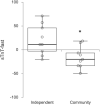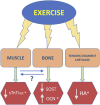Musculoskeletal Biomarkers Response to Exercise in Older Adults
- PMID: 35821851
- PMCID: PMC9261344
- DOI: 10.3389/fragi.2022.867137
Musculoskeletal Biomarkers Response to Exercise in Older Adults
Abstract
Exercise is an essential component of any good health style, being particularly important for older adults to counteract the effects of aging, including sarcopenia and osteoporosis, which can result in lower fall probability. Exercise programs for older adults are especially designed for that population. A rigorous evaluation of those programs is necessary to assure most benefit is achieved. Serum biomarkers of proteins intrinsic to musculoskeletal homeostasis could contribute objectively to the assessment of the benefits of exercise. In this work, in addition to the usual physical fitness and balance tests, ELISA assays quantified the serum levels of six proteins and one polysaccharide important for the homeostasis of muscle (troponin T and alpha-actinin), tendon/ligament (tenomodulin), cartilage (cartilage oligomeric matrix protein and hyaluronan) and bone (osteocalcin and sclerostin), before and after 8 weeks of an exercise program tailored to older adults, Stay Strong Stay Healthy, offered at a Community Center and at an Independent Senior Living facility. Statistical significance was determined by non-parametric tests (Wilcoxon Signed Ranks and Mann-Whitney U). Physical fitness and balance improved as expected along with a significant decrease in sclerostin, pointing to less inhibition of bone deposition. However, when considering each type of dwelling separately, older adults always saw a significant decrease of the isoform of troponin T associated with fast-twitch muscles, suggesting that daily levels of physical activity may also have a role in the benefit of older adults from exercise.
Keywords: aging; biomarker; exercise; musculoskeletal; osteocalcin; sclerostin; troponin T.
Copyright © 2022 Abreu, Vance, Cheng and Brotto.
Conflict of interest statement
The authors declare that the research was conducted in the absence of any commercial or financial relationships that could be construed as a potential conflict of interest.
Figures





Similar articles
-
Skeletal muscle troponin as a novel biomarker to enhance assessment of the impact of strength training on fall prevention in the older adults.Nurs Res. 2014 Mar-Apr;63(2):75-82. doi: 10.1097/NNR.0000000000000018. Nurs Res. 2014. PMID: 24589644
-
Prevention of falls and fall-related injuries in community-dwelling seniors: an evidence-based analysis.Ont Health Technol Assess Ser. 2008;8(2):1-78. Epub 2008 Oct 1. Ont Health Technol Assess Ser. 2008. PMID: 23074507 Free PMC article.
-
Examining the Delivery of a Tailored Chinese Mind-Body Exercise to Low-Income Community-Dwelling Older Latino Individuals for Healthy Aging: Feasibility and Acceptability Study.JMIR Form Res. 2022 Sep 13;6(9):e40046. doi: 10.2196/40046. JMIR Form Res. 2022. PMID: 35997685 Free PMC article.
-
A Review on Aging, Sarcopenia, Falls, and Resistance Training in Community-Dwelling Older Adults.Int J Environ Res Public Health. 2022 Jan 13;19(2):874. doi: 10.3390/ijerph19020874. Int J Environ Res Public Health. 2022. PMID: 35055695 Free PMC article. Review.
-
A review of the impact of exercise on fall rates among community-dwelling older adults.J Am Assoc Nurse Pract. 2021 Jul 5;34(2):247-251. doi: 10.1097/JXX.0000000000000636. J Am Assoc Nurse Pract. 2021. PMID: 34231546 Review.
Cited by
-
Effect of six weeks of resistance training on bone preservation in older adults: a randomized control trial.Aging Clin Exp Res. 2023 Nov;35(11):2633-2641. doi: 10.1007/s40520-023-02575-9. Epub 2023 Oct 14. Aging Clin Exp Res. 2023. PMID: 37838645 Clinical Trial.
-
Community-Dwelling Filipino Older Adults' Experiences with Virtual Coach for Health-Enhancing Physical Activity (HEPA): A Phenomenology.Nurs Rep. 2025 Jan 31;15(2):49. doi: 10.3390/nursrep15020049. Nurs Rep. 2025. PMID: 39997785 Free PMC article.
-
Risk of myocardial infarction and Osteoporosis: Insights from the 2015-2018 NHANES and Mendelian randomization Studies.Int J Cardiol Heart Vasc. 2024 Aug 28;55:101501. doi: 10.1016/j.ijcha.2024.101501. eCollection 2024 Dec. Int J Cardiol Heart Vasc. 2024. PMID: 39749285 Free PMC article.
References
-
- Abreu E. L., Cheng A.-L., Kelly P. J., Chertoff K., Brotto L., Griffith E., et al. (2014). Skeletal Muscle Troponin as a Novel Biomarker to Enhance Assessment of the Impact of Strength Training on Fall Prevention in the Older Adults. Nurs. Res. 63 (2), 75–82. 10.1097/NNR.0000000000000018 - DOI - PubMed
-
- Bates A., Furber S., Tiedemann A., Ginn K., van den Dolder P., Howard K., et al. (2018). Trial Protocol: Home-Based Exercise Programs to Prevent Falls and Upper Limb Dysfunction Among Community-Dwelling Older People: Study Protocol for the BEST (Balance Exercise Strength Training) at Home Randomised, Controlled Trial. J. Physiother. 64 (2), 121. 10.1016/j.jphys.2017.10.001 - DOI - PubMed
LinkOut - more resources
Full Text Sources

